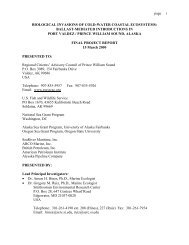Harmful Non-Indigenous Species in the United States - Aquatic ...
Harmful Non-Indigenous Species in the United States - Aquatic ...
Harmful Non-Indigenous Species in the United States - Aquatic ...
You also want an ePaper? Increase the reach of your titles
YUMPU automatically turns print PDFs into web optimized ePapers that Google loves.
34 I <strong>Harmful</strong> <strong>Non</strong>-<strong>Indigenous</strong> <strong>Species</strong> <strong>in</strong> <strong>the</strong> <strong>United</strong> <strong>States</strong>The Park Service alone cannot solve its press<strong>in</strong>gresource management problems. Up to 70percent of <strong>the</strong> external threats to Parks result fromactions by o<strong>the</strong>r Federal agencies or by State orlocal governments (75). This suggests NPS mustwork closely with adjacent land managers. Specifically,Congress could require that NPS <strong>in</strong>itiateagreements for manag<strong>in</strong>g those NIS that threatenpark lands from outside <strong>the</strong>ir boundaries. Thoseprojects that serve multiple goals, e.g., NISremoval and recovery of endangered species, are<strong>the</strong> best candidates for top priority (6).A Keystone Center Policy Dialogue on biologicaldiversity (47) suggested an agency-byagencyapproach to NIS on public lands. Participantsrecommended that each agency: prohibitpotentially harmful new releases of NIS, <strong>in</strong>clud<strong>in</strong>gany <strong>in</strong>tended to control <strong>in</strong>digenous species;identify, control, or replace already establishedNIS; elim<strong>in</strong>ate any newly discovered NIS; andma<strong>in</strong>ta<strong>in</strong> those beneficial NIS that do not <strong>in</strong>terferewith biological diversity.Congress’ 1990 amendments to <strong>the</strong> FNWAtook a similar approach, requir<strong>in</strong>g each agency todevelop plans for weed control on lands under itsjurisdiction. The FNWA could fur<strong>the</strong>r protectnatural areas if this function were more explicit(98). The def<strong>in</strong>ition of a Federal noxious weed<strong>in</strong>cludes species affect<strong>in</strong>g ‘‘fish and wildliferesources. Never<strong>the</strong>less, critics compla<strong>in</strong> thatAPHIS has been slow or failed to act on weeds ofnatural areas such as melaleuca and Australianp<strong>in</strong>e (Casuar<strong>in</strong>a equisetfolia) (ch. 8). At leastone State—Wash<strong>in</strong>gton-has recently providedmore complete protection for natural areas fromweeds (box 7-D) (124).Improved implementation of <strong>the</strong> Lacey Act andfuture implementation of <strong>the</strong> <strong>Non</strong><strong>in</strong>digenous<strong>Aquatic</strong> Nuisance Prevention and Control Actmight go far towards protect<strong>in</strong>g natural areasfrom harmful, non-<strong>in</strong>digenous fish and wildlife(<strong>in</strong>clud<strong>in</strong>g aquatic <strong>in</strong>vertebrates). Today, however,protection of natural areas from <strong>the</strong>se NIS isalmost nonexistent. For example, mollusks thatharm natural areas cont<strong>in</strong>ue to arrive <strong>in</strong> <strong>the</strong>country (ch. 3) (8). APHIS may screen out somemollusks dur<strong>in</strong>g <strong>in</strong>spection of plant imports, butonly if <strong>the</strong>y are potential agricultural pests. Justone species would be stopped due to a prohibitionunder <strong>the</strong> Lacey Act—<strong>the</strong> well-known zebramussel, which was listed far too late to stop itsspread across <strong>the</strong> country.Congress might delay fur<strong>the</strong>r legislation onharmful aquatic NIS until <strong>the</strong> 1990 <strong>Non</strong><strong>in</strong>digenous<strong>Aquatic</strong> Nuisance Prevention and ControlAct is fully implemented, although <strong>the</strong> Federal<strong>in</strong>teragency <strong>Aquatic</strong> Nuisance <strong>Species</strong> Task Forcehas been slow to fulfill its required assignments(table 6-l). Instead, Congress might evaluate <strong>the</strong>Task Force program to date, urge faster implementation,and ensure that funds are provided forState control <strong>in</strong> a timely manner.Issue 5: Environmental Educationas PreventionOption: Congress could require that <strong>the</strong> 20-someFederal agencies <strong>in</strong>volved with NIS developbroadly based environmental educationprograms to <strong>in</strong>crease public awareness ofproblems caused by damag<strong>in</strong>g orunpredictable NIS.Option: Alternately, Congress could develop asmaller scale <strong>in</strong>itiative to take greateradvantage of current programs and<strong>in</strong>formation.Option: Congress could require that airl<strong>in</strong>es,port authorities, and importers <strong>in</strong>tensify <strong>the</strong>irpublic educational efforts regard<strong>in</strong>g harmfulNIS.Although public appreciation of U.S. biologicaldiversity is <strong>in</strong>creas<strong>in</strong>g (ch. 4), <strong>the</strong> differencebetween <strong>in</strong>digenous and NIS <strong>in</strong> natural surround<strong>in</strong>gsis not commonly perceived—thus <strong>the</strong> neglectof a coherent public policy regard<strong>in</strong>gharmful NIS.Lack of awareness on <strong>the</strong> part of <strong>the</strong> public andpolicymakers is mutually re<strong>in</strong>forc<strong>in</strong>g. Many,














